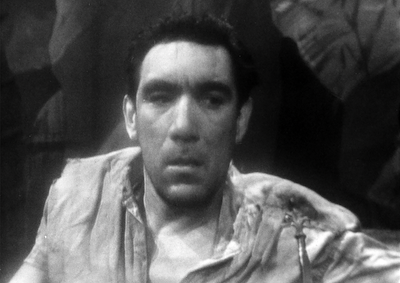Admission is free. No advance reservations. Seats are available on a first come, first served basis. Hammer Museum members will have reserved seating available at the box office. The box office opens one hour before the first program of the day.
As a sub-genre, “atomic television” dates back to the medium’s formative years, as the small screen attempted to reckon with the escalating existential dangers posed by the Cold War throughout the 1950s and ’60s. Outré anthology TV programs of the era, such as Lights Out (1951) and Way Out (1961), offered an unexpected platform for the meaningful exploration of questions wrought by life under the Bomb, dramatizing all-too-plausible doomsday scenarios within horror, science fiction and fantasy contexts.
Lights Out: “The House of Dust”
U.S., 2/5/1951
With original commercials
In this live episode, future Academy Award winner Anthony Quinn (Viva Zapata!) stars as one of the last survivors of a global nuclear war. While a chance encounter with another survivor (Nina Foch) points to a new tomorrow, the pair must first fight for their lives against a terrifying scourge created in the bomb’s aftermath. The low-budget production features expressionistic sets and innovative sound design that illuminate early television’s artistic and technical ingenuity while simultaneously adhering to stylistic elements of radio (an emphasis on sound effects; organ accompaniment to punctuate the drama).—Mark Quigley
DCP, b&w, 30 min. NBC. Producer: Herbert Swope, Jr. Director: Laurence Schwab, Jr. Writer: A.J. Russell. With: Frank Gallop, Anthony Quinn, Nina Foch.
Preservation funded by the John H. Mitchell Television Preservation Endowment. Digitally preserved by the UCLA Film & Television Archive from a 16mm composite kinescope. Laboratory services by Endpoint Audio Labs. Special thanks to Thousand Oaks Library Foundation.
Way Out: “Button, Button”
With original commercials
U.S., 4/28/1961
Produced on black-and-white videotape, the macabre series Way Out achieved cult status for its darkly off-kilter sensibilities and relative scarcity (it is only known to survive on 16mm kinescopes and was never released to home video). In this nightmarish episode, a military captain (Tim O’Connor) in command of a missile silo faces the grim possibility of a nuclear launch by an unstable sergeant (Warren Finnerty, star of Shirley Clarke’s The Connection). Hosted by author Roald Dahl, the mid-season replacement series served briefly as the lead-in for The Twilight Zone on CBS before cancellation after only 14 episodes.—Mark Quigley
DCP, b&w, 29 min. CBS. Executive Producer: David Susskind. Producer: Jacqueline Babbin. Director: Tom Donovan. Writer: Elliott Baker. With: Roald Dahl, Tim O’Connor, Warren Finnerty, William Traylor.
Preservation funded by the John H. Mitchell Television Preservation Endowment. Digitally preserved by the UCLA Film & Television Archive in collaboration with Paramount Pictures Archive and Wisconsin Center for Film and Theater Research (WCFTR) from 16mm kinescope picture and track negatives and a composite kinescope. Laboratory services by FotoKem, Endpoint Audio Labs. Special thanks to Andrea Kalas, Charlotte Barker, Graham Marshall, Amanda Smith, Peter Murray, Patrick Scheg. Use courtesy of CBS Studios.






 Mobile Navigation
Mobile Navigation

